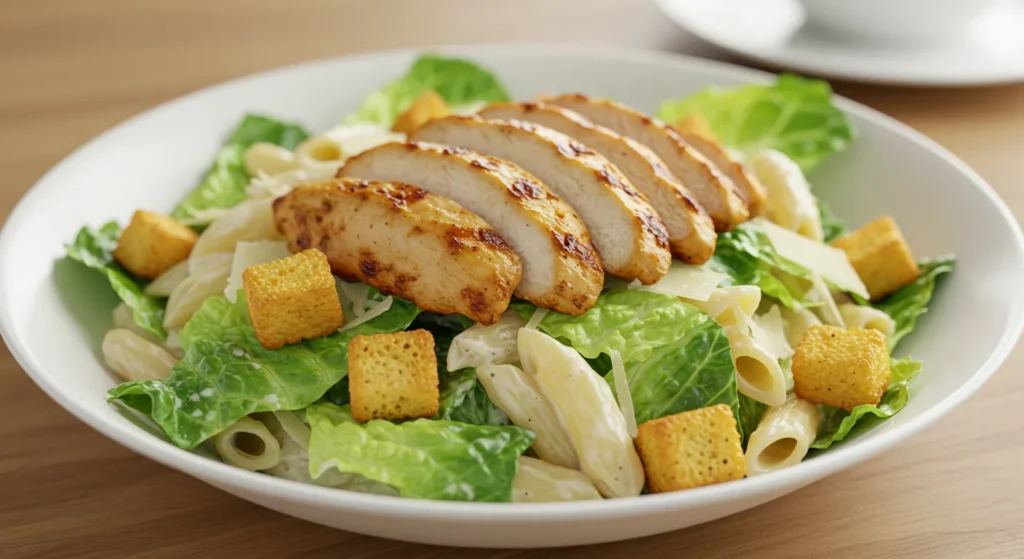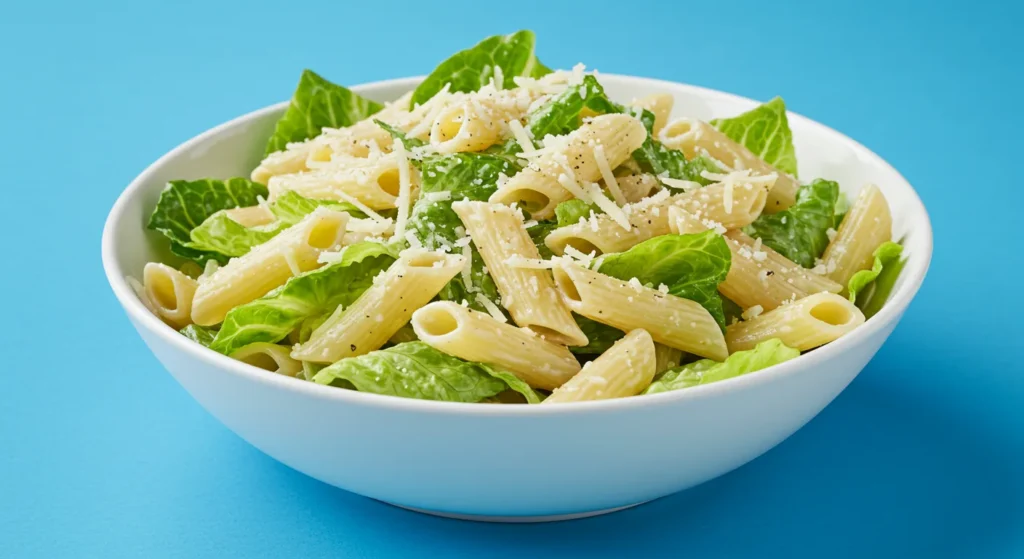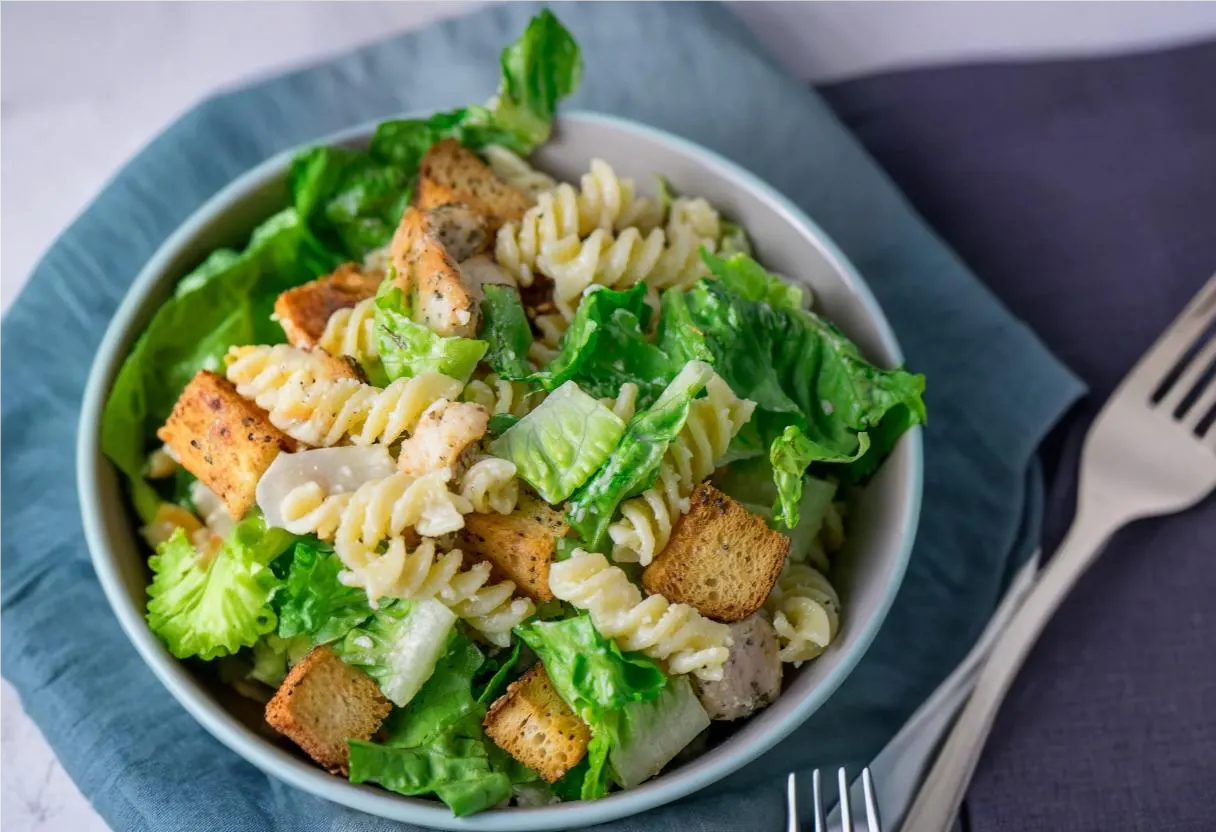Learn to craft a hearty Caesar pasta salad brimming with crisp lettuce, tangy dressing, and satisfying pasta for a crowd-pleasing meal.
Introduction
Caesar Pasta Salad has become a beloved twist on the classic Caesar Salad, especially among families looking for a more substantial dish. While traditional Caesar Salad usually features crisp romaine lettuce, creamy dressing, and crunchy croutons, this creative version incorporates a hefty serving of perfectly cooked pasta. Therefore, the result is a dish that retains the classic Caesar flavor but also turns it into a satisfying, full meal.
In the United States, this pasta-based Caesar recipe appears frequently at backyard gatherings, potlucks, and even quick midweek lunches. Its adaptability to various dietary needs makes it appealing, and its mix of crisp greens and savory dressing feels both comforting and refreshing. In this ultimate guide, you will learn how to select the right pasta, craft or choose a flavorful dressing, add proteins of your choice, and store leftovers efficiently.
Moreover, we will delve into its fascinating origins, explore different ways to customize it, and answer frequently asked questions. By the end, you will be able to create your own unique Caesar Pasta Salad that suits your taste and dietary preferences, all while preserving the essence of this iconic dish. Let’s begin!
- Introduction
- A Brief History of Caesar Salad
- Why Caesar Salad Becomes a Pasta Dish
- Essential Ingredients for Caesar Pasta Salad
- Detailed Caesar Pasta Salad Recipe
- Nutritional Information
- Top Variations and Customizations
- Serving Suggestions and Occasions
- Storage and Make-Ahead Tips
- Caesar Pasta Salad FAQ
- Conclusion
A Brief History of Caesar Salad
Caesar Salad, contrary to popular belief, did not originate in Italy. Instead, many historians credit its creation to Caesar Cardini, an Italian-born restaurateur who lived in Tijuana, Mexico. The story goes that, in the early 1920s, a sudden influx of customers led him to improvise a salad from a handful of basic ingredients on hand.
He allegedly combined romaine lettuce, a creamy mixture of egg yolks and olive oil, garlic, and a few other components—now recognized as the foundation for classic Caesar dressing. Over time, this salad took the culinary world by storm, eventually gaining enormous popularity in the United States. Although numerous theories exist about who exactly invented it, the flavor profile of zesty lemon, savory garlic, salty Parmesan, and crisp greens has remained a mainstay in modern cuisine.
Today, Caesar Salad appears on countless menus worldwide. However, the addition of pasta in a “Caesar Pasta Salad” is a more contemporary American innovation. This new spin preserves the dressing’s tangy appeal but enriches the dish with hearty noodles. Therefore, you can serve it as both a robust side and a stand-alone entrée.
Why Caesar Salad Becomes a Pasta Dish
You may be wondering why anyone would add pasta to a salad that is already well-loved. However, there are several reasons to combine pasta with the beloved Caesar concept:
- Hearty Appeal: Traditional Caesar Salad is light and fresh. By integrating pasta, you gain extra substance, making the meal more filling.
- Pasta Soaks Up Flavor: Pasta is a versatile canvas that absorbs the creamy dressing. Therefore, each bite bursts with tangy flavor.
- Great for Feeding a Crowd: Adding pasta increases the yield without diluting the original essence of the Caesar. This transformation ensures you can feed more people during gatherings or family dinners.
- Adaptable: Caesar Pasta Salad can easily accommodate different proteins or even be made vegetarian. This versatility keeps it interesting.
These benefits explain why Caesar Pasta Salad has quickly become a favorite in the U.S. If you love a dish that strikes a balance between healthy greens and the comforting feel of noodles, this recipe is perfect.
For another quick dish with a twist, try our hibachi-noodle-recipe and serve it alongside fresh greens.
Essential Ingredients for Caesar Pasta Salad
A great Caesar Pasta Salad requires attention to each element, ensuring that nothing overshadows another. Hence, selecting the best pasta, freshest greens, and a creamy dressing is key.
Choosing the Right Pasta
When aiming for a pasta-based Caesar dish, consider short, sturdy pasta shapes. Options like:
- Rotini
- Penne
- Farfalle
- Fusilli
These shapes each trap dressing in their spirals or ridges, maximizing flavor in every bite. Always cook the pasta al dente, typically following the package instructions. Al dente pasta has a pleasant chew, preventing it from turning mushy once mixed with dressing.
Leafy Greens: Crisp and Fresh
Romaine lettuce serves as the foundation for a classic Caesar. Its crisp structure holds up well under creamy sauces. If you can’t find romaine, you might try:
- Baby kale
- Butter lettuce
- Green leaf lettuce
However, romaine is still the top choice if you want to preserve that essential crunch. To keep your greens from wilting, always pat them dry or use a salad spinner. Moreover, chop or tear them into bite-sized pieces just before assembling.
Crafting the Creamy Dressing
The hallmark of Caesar Salad is its dressing. While many store-bought options exist, homemade versions let you tailor the taste. Basic ingredients include:
- Egg yolks (or pasteurized egg product)
- Anchovy fillets or anchovy paste for that signature savory note
- Fresh garlic
- Extra-virgin olive oil
- Parmesan cheese (finely grated)
- Lemon juice for tang
- Black pepper
Although anchovies might seem intimidating, they provide a subtle but important depth. If you’re concerned about raw egg, you can replace egg yolks with a spoonful of mayonnaise or use pasteurized eggs. The goal is to balance creamy, tangy, and umami flavors so that the dressing complements the greens and pasta without overpowering them.
Protein Possibilities

To turn Caesar Pasta Salad into a complete meal, you can add:
- Grilled chicken
- Roasted turkey
- Pan-seared shrimp
- Vegetarian substitutes (tofu cubes or chickpeas)
Since the dressing contains an umami punch, a lightly seasoned protein usually works best. For example, you can marinate chicken breasts in garlic and pepper. Then, grill or bake them to add a new layer of flavor.
Flavorful Extras
Another reason Caesar Pasta Salad is popular lies in its potential for customization. You can add:
- Croutons (store-bought or homemade)
- Cherry tomatoes for extra color
- Olives or roasted red peppers
- Roasted chickpeas for crunch
Croutons are integral to a classic Caesar, but you might experiment with homemade versions for added freshness. Whatever you choose, keep in mind that the dressing tends to be rich, so balance the salad with fresh or subtly flavored additions.
Detailed Caesar Pasta Salad Recipe

This recipe merges crisp lettuce, tangy dressing, and tender pasta. It uses common ingredients, making it ideal for both casual home cooks and those seeking something special.
Ingredients List
Serves 6 to 8:
- 12 ounces of penne pasta (or your favorite shape)
- 1 large head of romaine lettuce, chopped into bite-sized pieces
- 2 cups cooked protein of choice (e.g., grilled chicken, roasted turkey, or tofu)
- 1 cup croutons
- 1 cup finely shredded Parmesan cheese (or a vegetarian cheese alternative if you prefer)
- Freshly ground black pepper, to taste
Homemade Caesar Dressing
- 2 large egg yolks (or 2 tablespoons of pasteurized egg product)
- 1 teaspoon anchovy paste (or 2 finely chopped anchovy fillets)
- 1 garlic clove, minced
- 2 tablespoons fresh lemon juice
- ½ teaspoon Dijon mustard
- ¼ cup finely grated Parmesan cheese
- ¼ cup extra-virgin olive oil
- Pinch of salt and pepper
Step-by-Step Instructions
1- Boil the Pasta
- Fill a large pot with water and bring it to a boil. Add a pinch of salt to enhance flavor.
- Stir in the penne (or chosen pasta) and cook until al dente, following the package instructions.
- Drain the pasta and rinse it under cold water. This step not only stops further cooking but also removes excess starch, preventing clumping.
2- Prepare the Dressing
- In a medium bowl, whisk the egg yolks (or pasteurized substitute), anchovy paste, minced garlic, lemon juice, and Dijon mustard until thoroughly combined.
- Slowly drizzle in the olive oil while whisking. This helps emulsify the dressing.
- Stir in the grated Parmesan cheese, plus a pinch of salt and pepper.
- Taste and adjust the seasoning with more lemon juice, salt, or pepper if needed.
3- Cook or Prep Your Protein
- If you are using grilled chicken or turkey, season it lightly with pepper (and herbs if you like). Cook in a pan or grill until done. Cut it into slices or cubes.
- If using tofu, press it to remove excess moisture, then pan-fry or bake until it turns golden.
4- Combine the Pasta and Lettuce
- Place the drained, cooled pasta in a large serving bowl.
- Add the chopped romaine lettuce. Toss briefly to distribute the greens evenly.
5- Add Dressing
- Pour the dressing over the pasta and lettuce. Use tongs or a large spoon to toss gently until everything is coated. Be sure to reach the bottom of the bowl for even coverage.
6- Incorporate Protein and Extras
- Fold in your sliced chicken, turkey, or tofu.
- Add croutons and half of your Parmesan cheese. Reserve the remaining cheese for garnish.
- Toss once again to combine.
7- Finish and Serve
- Sprinkle the remaining Parmesan cheese on top.
- Grind black pepper over the surface.
- Serve immediately to enjoy the fresh crispness of the lettuce.
This Caesar Pasta Salad tastes best fresh, but you can refrigerate leftovers in an airtight container for a day or two. If the salad dries out, add a drizzle of olive oil or a spoonful of leftover dressing before serving again.
Craving extra protein in your meals? Check out this jalapeno-chicken-recipe to pair with your Caesar Pasta Salad.
Nutritional Information
Below is an approximate nutritional profile per 100g of Caesar Pasta Salad, including lettuce, pasta, chicken, homemade dressing, and Parmesan cheese. However, note that exact figures may vary according to specific ingredient brands and serving sizes.
| Nutrient | Amount per 100g |
|---|---|
| Calories | 190 kcal |
| Carbohydrates | 23 g |
| Protein | 8 g |
| Fat | 7 g |
| Saturated Fat | 2 g |
| Fiber | 2 g |
| Sodium | 270 mg |
| Cholesterol | 25 mg |
| Calcium | 90 mg |
This table demonstrates that Caesar Pasta Salad offers a balanced combination of carbohydrates, proteins, and fats, making it a satisfying meal. Nevertheless, you can adjust the recipe to lighten the overall fat content by using low-fat dressing alternatives or skipping some cheese.
Top Variations and Customizations
Caesar Pasta Salad can be tailored in numerous ways to suit different dietary needs or taste preferences. Below are popular adaptations:
Vegetarian-Friendly Options
- Skip Anchovies: While anchovies provide signature umami, you can replace them with an extra dash of salt or even capers.
- Use Vegetarian Cheese: Some Parmesan cheeses are made without animal rennet. Also, nutritional yeast can lend a cheesy flavor if that is your preference.
- Add Roasted Chickpeas: For a plant-based protein boost, roast chickpeas with olive oil and seasoning until crunchy.
Gluten-Free and Dairy-Free Options
- Pasta Substitutions: Swap traditional wheat pasta with gluten-free variants like rice, quinoa, or lentil pasta.
- Dairy-Free Dressing: Use vegan mayonnaise or omit cheese entirely. Additionally, you can include more herbs and garlic to maintain flavor depth.
Creative Twists
- Roasted Veggies: For example, roasted bell peppers or zucchini can bring extra nutrients and color to your salad.
- Different Greens: Substitute half the romaine with kale or spinach for more vitamins.
- Tangy Add-Ons: A squeeze of lemon juice or a spoonful of mustard can brighten flavors further.
In addition, you can modify how you cook your protein. Marinating chicken in fresh herbs or even lemony dressings can add new dimensions without overshadowing the Caesar foundation.
Serving Suggestions and Occasions
Because Caesar Pasta Salad is remarkably flexible, you can serve it in countless scenarios:
- Daily Lunch: Pack it in a reusable container for an office lunch, or enjoy it at home for a quick yet delicious mid-day meal.
- Family Dinners: Serve it as a side with other simple dishes like roasted vegetables. Alternatively, double the recipe to feed a large family.
- Potlucks: Bring this dish to social gatherings. Since it combines pasta and lettuce, guests can enjoy a bit of everything in one bowl.
- Holiday Gatherings: It’s also an excellent addition to festive spreads. The crisp lettuce and cool dressing can balance out heavier holiday fare.
In every setting, Caesar Pasta Salad stands out with its delightful crunchy texture, tangy flavor, and comforting pasta base.
Storage and Make-Ahead Tips
Although Caesar Pasta Salad is best consumed fresh, proper storage can let you enjoy it for up to two days.
- Keep Components Separate: If you want to prep in advance, cook the pasta, wash the lettuce, and blend the dressing. Store each element in the refrigerator in separate containers.
- Combine Right Before Serving: Mix the pasta, lettuce, and dressing just before mealtime so the lettuce remains crispy.
- Leftovers: Transfer any extra salad into an airtight container. If the salad looks dry the next day, add a small spoonful of leftover dressing or even just a drizzle of olive oil to refresh it.
- Food Safety: Because Caesar dressing can involve raw egg yolks, practice caution. Opt for pasteurized eggs or store-bought dressing if you’re concerned. Keep the salad chilled and avoid leaving it at room temperature for more than two hours.
By following these guidelines, you can uphold both flavor and safety, ensuring that your Caesar Pasta Salad remains appealing.
If you love hearty pasta ideas, you might enjoy our pea-pasta-recipe for more creative inspiration.
Caesar Pasta Salad FAQ
Below are detailed answers to popular questions, including some specifically requested PAA (People Also Ask) items.
What are the five mistakes to avoid pasta salad?
- Overcooking the Pasta: Always aim for al dente. Overdone pasta becomes mushy and disintegrates when you mix it with dressing.
- Skipping the Salt: If you don’t salt the cooking water, your pasta might taste bland. A well-seasoned base is important for overall flavor.
- Dressing the Pasta When It’s Hot: For cold salads, it’s often best to cool the pasta first so the dressing won’t turn gummy. However, you can toss it lightly while warm with a splash of olive oil to help flavors absorb.
- Using Watery Greens: Excess water on lettuce dilutes the dressing, leading to a soggy salad. Always pat the lettuce dry.
- Lack of Seasoning: Taste as you go. Small additions of salt, pepper, or lemon juice can elevate the final result tremendously.
What does a classic Caesar salad contain?
A classic Caesar salad typically consists of:
- Romaine lettuce
- Creamy dressing (often made with egg yolks, anchovies, Parmesan, garlic, and lemon juice)
- Parmesan cheese
- Croutons
- Black pepper
Its flavor profile stands out due to the combination of tangy lemon, savory anchovies, and Parmesan.
How do you make Gordon Ramsay’s Caesar salad?
While Gordon Ramsay’s exact recipe can vary, he usually focuses on fresh, high-quality ingredients and a well-emulsified dressing. His approach often includes:
- Preparing fresh croutons: He toasts bread cubes with a bit of oil or butter.
- Homemade dressing: Anchovies, garlic, and Parmesan are blended with egg yolks or mayonnaise.
- Layering: He dresses romaine lettuce gently, ensuring every leaf is coated but not drenched.
- Presentation: He frequently arranges leaves in a stylish manner and garnishes with additional Parmesan and black pepper.
What do they call Caesar salad in Italy?
Interestingly, Caesar Salad is not a traditional Italian dish. Therefore, you might not find a direct translation or a common name in Italy. Italians often refer to it simply as “Caesar Salad.” Although it has an Italian-sounding name, the dish was popularized in Mexico and the United States, rather than being homegrown in Italy.
Conclusion
In conclusion, Caesar Pasta Salad offers a wonderful blend of crisp romaine lettuce, creamy and tangy dressing, and the hearty texture of pasta. This pasta-based Caesar recipe can be as versatile as you want it to be—whether you prefer traditional elements like anchovies or lean more toward vegetarian and gluten-free alternatives.
Remember to avoid overcooking your pasta, always balance your seasoning, and consider your dietary needs when customizing. By following the tips in this guide—from selecting the right noodles to properly storing leftovers—you will develop a reliable go-to Caesar Pasta Salad. Most importantly, it’s a dish that can adapt to any occasion, from quiet family meals to large group gatherings.
Enjoy your flavorful, hearty twist on the classic Caesar Salad!

